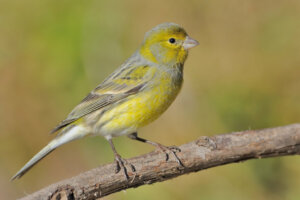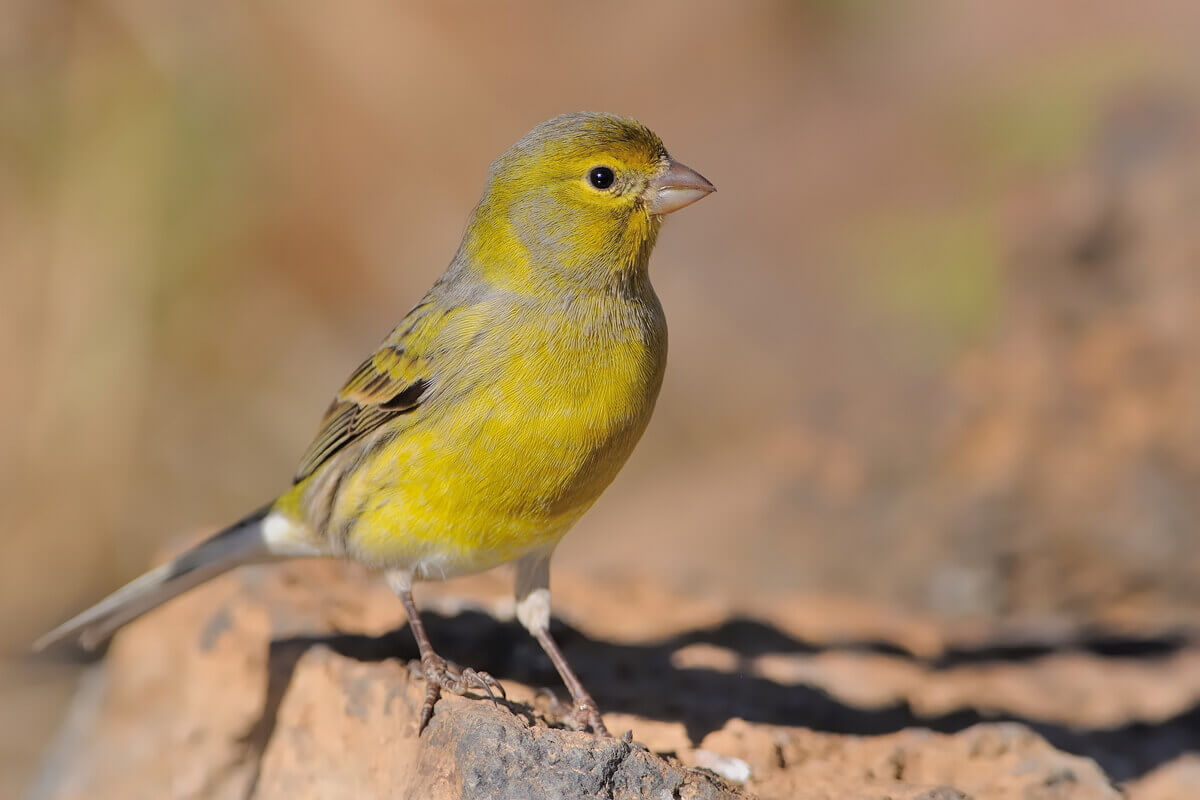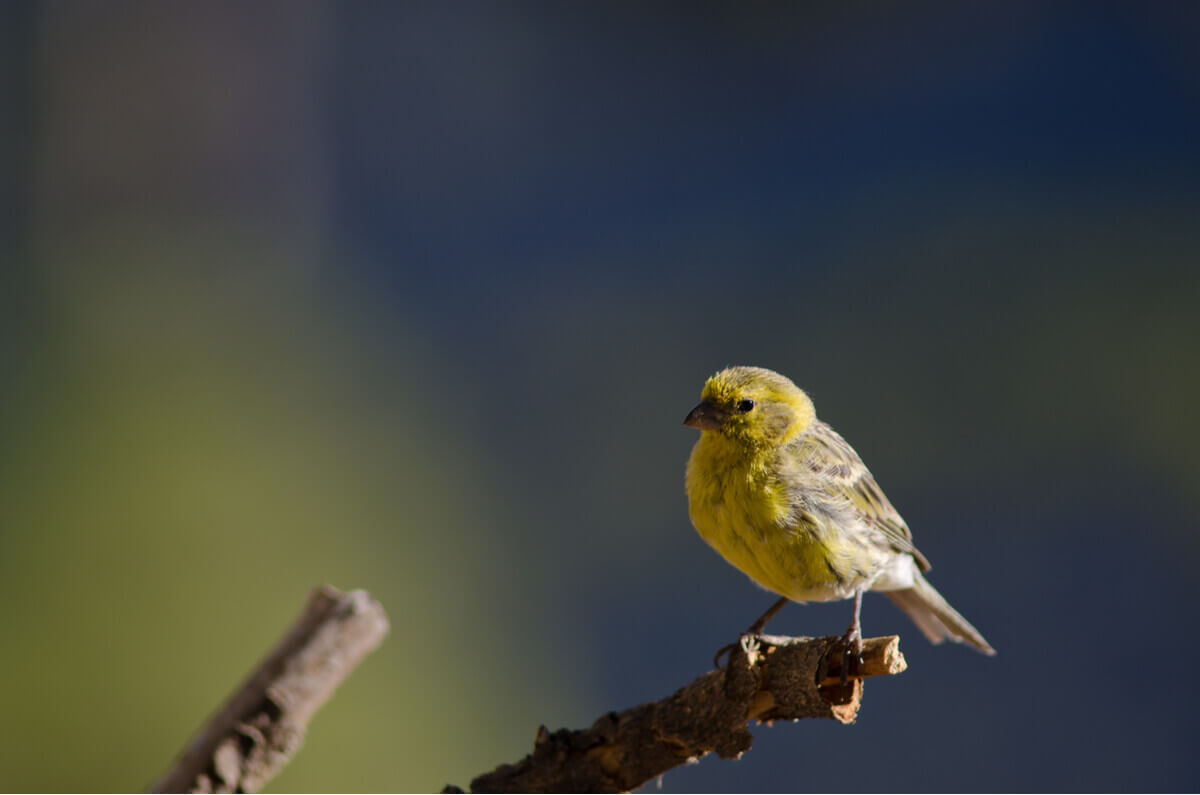The Behavior of Canaries

These birds and their beautiful song are known worldwide. However, the behavior of canaries isn’t a field that’s been studied much beyond their status as decorative birds. For example, their social dynamics outside of a cage still remain a mystery to most of the general population.
In this article, you’ll find a review of the behavioral habits of the wild canary. If you’ve ever wondered how these birds live in the wild, You’ve come to the right place. Keep reading!
The characteristics of canaries
The wild canary (Serinus canaria) is a passerine bird of the family Fringillidae of small size (about 8-9 inches wingspan). Unlike domestic canaries, its yellowish color is dotted with brown and black striations that allow it to blend in with its surroundings.
It’s a bird with no known subspecies in the wild and is distributed in Madeira, the Azores, and the Canary Islands. It’s also been introduced in Bermuda, Hawaii, and Puerto Rico. It occupies a wide variety of environments and can be seen from sea level to 6550 feet of altitude, mainly in semi-open areas and woodlands.
The canary’s diet consists mainly of seeds that it forages on the ground. At high altitudes, it feeds on fruits, buds, and buds of trees. Occasionally it consumes animal protein in the form of small insects, such as beetle larvae or small orthoptera.
The canary usually breeds 2 or 3 times a year and its reproductive period begins in March and ends in July. However, populations living in warmer areas may start nesting in January. The female lays 3 to 5 eggs which she incubates for 2 weeks and the chicks become independent 2-3 weeks after hatching.
The variant bred in captivity is known as Serinus canaria domestica and is quite different from the wild morphotype.

The social behavior of canaries
Canaries are grouped in flocks of up to 30 individuals. Within these groups, they usually associate in pairs that defend a small area in which they feed and rest. Even so, they’re not excessively territorial birds.
When night falls, the canaries all leave together to look for a leafy tree that will serve as a roost. There, there’s a hubbub of trilling and flapping until they all settle down and compete for a good perch to sleep on.
In fact, these birds tend to associate with other species in places where food is plentiful, such as with the red-fronted canary (Serinus pusillus) or the common linnet (Linaria cannabina). This strategy allows them to locate their predators more easily, as well as to find new food sources more quickly.
Feeding behavior
The feeding behavior of canaries is tireless: They spend most of the day searching for food, either on the ground or in the trees. Although they move in flocks, experts have observed that each pair chooses a certain area and that fights occur when the adult birds invade the area of other conspecifics.
Within these foraging periods, there are moments of rest, in which the flock goes up into the trees. There, the birds continue feeding if they can, but in a more relaxed way: They prefer to doze, socialize, and preen.
Canary breeding behavior
The breeding behavior of canaries is probably the most studied area of knowledge about this species, mainly due to the interest in their beautiful and complex song. Their courtship behavior is directly related to the tones emitted by the male, as you’ll see below.
When the breeding season arrives, males compete for females and form pairs that will be stable throughout this period. To attract attention, they’ll use their song and a specific pose, in which they stretch upwards and move along the branches in front of the female.
While the female is in charge of hatching the eggs, the male provides her with food. Since they’re not very territorial birds in their natural environment, it’s common for several pairs to share a breeding space. They usually build their nest in the branches of trees or bushes, which is cup-shaped.
The canary builds its nest by weaving a dense network of fine branches, roots, lichen, and moss. It also lines the inside with feathers and fur to make it more comfortable and warm for the young.
The canary’s song
The canary’s song is made up of a highly complex string of warbles and chirps. Although the tonality emitted seems similar in all the male specimens, there are many factors that condition this vocalization:
- Parental learning: The song of this bird has been studied in comparative psychology because of parallels with human language acquisition. It seems that the chicks learn the song by looking at their parents’ song and that of other nearby birds.
- Learning during the breeding season: Females also have preferences influenced by experience when it comes to preferring the song of one male over another. Males, in turn, perfect their song in order to attract as many females as possible.
- Environmental sounds: In an experiment carried out in captivity, it was possible to influence the females’ preferences through early exposure to recordings of different calls and songs.
The song of canaries presents a clear hormonal trigger, something that explains why only males are able to tune it. Females also emit certain sounds, but these are much more basic.

As you can see, these passerines have a lot to say about their behavior. Don’t be fooled by the small birds: They try hard to go unnoticed, but if you have the chance to observe them, you’ll discover a whole world of curiosities.
These birds and their beautiful song are known worldwide. However, the behavior of canaries isn’t a field that’s been studied much beyond their status as decorative birds. For example, their social dynamics outside of a cage still remain a mystery to most of the general population.
In this article, you’ll find a review of the behavioral habits of the wild canary. If you’ve ever wondered how these birds live in the wild, You’ve come to the right place. Keep reading!
The characteristics of canaries
The wild canary (Serinus canaria) is a passerine bird of the family Fringillidae of small size (about 8-9 inches wingspan). Unlike domestic canaries, its yellowish color is dotted with brown and black striations that allow it to blend in with its surroundings.
It’s a bird with no known subspecies in the wild and is distributed in Madeira, the Azores, and the Canary Islands. It’s also been introduced in Bermuda, Hawaii, and Puerto Rico. It occupies a wide variety of environments and can be seen from sea level to 6550 feet of altitude, mainly in semi-open areas and woodlands.
The canary’s diet consists mainly of seeds that it forages on the ground. At high altitudes, it feeds on fruits, buds, and buds of trees. Occasionally it consumes animal protein in the form of small insects, such as beetle larvae or small orthoptera.
The canary usually breeds 2 or 3 times a year and its reproductive period begins in March and ends in July. However, populations living in warmer areas may start nesting in January. The female lays 3 to 5 eggs which she incubates for 2 weeks and the chicks become independent 2-3 weeks after hatching.
The variant bred in captivity is known as Serinus canaria domestica and is quite different from the wild morphotype.

The social behavior of canaries
Canaries are grouped in flocks of up to 30 individuals. Within these groups, they usually associate in pairs that defend a small area in which they feed and rest. Even so, they’re not excessively territorial birds.
When night falls, the canaries all leave together to look for a leafy tree that will serve as a roost. There, there’s a hubbub of trilling and flapping until they all settle down and compete for a good perch to sleep on.
In fact, these birds tend to associate with other species in places where food is plentiful, such as with the red-fronted canary (Serinus pusillus) or the common linnet (Linaria cannabina). This strategy allows them to locate their predators more easily, as well as to find new food sources more quickly.
Feeding behavior
The feeding behavior of canaries is tireless: They spend most of the day searching for food, either on the ground or in the trees. Although they move in flocks, experts have observed that each pair chooses a certain area and that fights occur when the adult birds invade the area of other conspecifics.
Within these foraging periods, there are moments of rest, in which the flock goes up into the trees. There, the birds continue feeding if they can, but in a more relaxed way: They prefer to doze, socialize, and preen.
Canary breeding behavior
The breeding behavior of canaries is probably the most studied area of knowledge about this species, mainly due to the interest in their beautiful and complex song. Their courtship behavior is directly related to the tones emitted by the male, as you’ll see below.
When the breeding season arrives, males compete for females and form pairs that will be stable throughout this period. To attract attention, they’ll use their song and a specific pose, in which they stretch upwards and move along the branches in front of the female.
While the female is in charge of hatching the eggs, the male provides her with food. Since they’re not very territorial birds in their natural environment, it’s common for several pairs to share a breeding space. They usually build their nest in the branches of trees or bushes, which is cup-shaped.
The canary builds its nest by weaving a dense network of fine branches, roots, lichen, and moss. It also lines the inside with feathers and fur to make it more comfortable and warm for the young.
The canary’s song
The canary’s song is made up of a highly complex string of warbles and chirps. Although the tonality emitted seems similar in all the male specimens, there are many factors that condition this vocalization:
- Parental learning: The song of this bird has been studied in comparative psychology because of parallels with human language acquisition. It seems that the chicks learn the song by looking at their parents’ song and that of other nearby birds.
- Learning during the breeding season: Females also have preferences influenced by experience when it comes to preferring the song of one male over another. Males, in turn, perfect their song in order to attract as many females as possible.
- Environmental sounds: In an experiment carried out in captivity, it was possible to influence the females’ preferences through early exposure to recordings of different calls and songs.
The song of canaries presents a clear hormonal trigger, something that explains why only males are able to tune it. Females also emit certain sounds, but these are much more basic.

As you can see, these passerines have a lot to say about their behavior. Don’t be fooled by the small birds: They try hard to go unnoticed, but if you have the chance to observe them, you’ll discover a whole world of curiosities.
All cited sources were thoroughly reviewed by our team to ensure their quality, reliability, currency, and validity. The bibliography of this article was considered reliable and of academic or scientific accuracy.
- Lerch, A., Rat‐Fischer, L., & Nagle, L. (2013). Condition‐dependent choosiness for highly attractive songs in female canaries. Ethology, 119(1), 58-65.
- Depraz, V., Leboucher, G., & Kreutzer, M. (2000). Early tutoring and adult reproductive behaviour in female domestic canary (Serinus canaria). Animal Cognition, 3(1), 45-51.
- Diez-Bernardo, M. (2009). Estudio sobre la agresividad del pájaro canario Serinus canaria. Anales universitarios de etología.
- SEO/BirdLife. (2018, 4 mayo). Serín canario. https://seo.org/ave/canario/
This text is provided for informational purposes only and does not replace consultation with a professional. If in doubt, consult your specialist.








